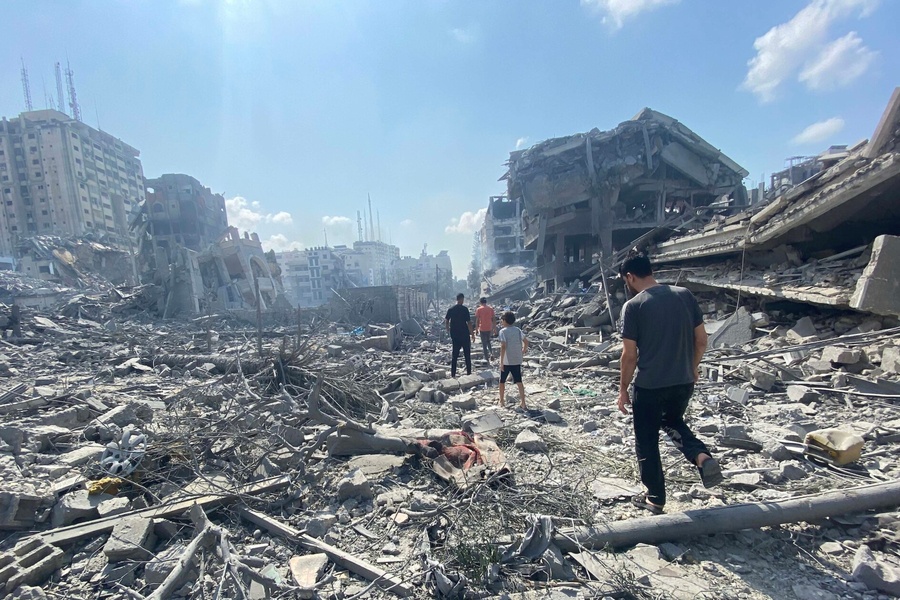Trump Preparing Response to Assad Regime’s Chemical Attack
Dozens Killed in Chemical Weapons Attack in Douma
Published by The Lawfare Institute
in Cooperation With

Dozens Killed in Chemical Weapons Attack in Douma
More than 60 people were killed and more than 500 others required medical attention after a brutal chemical attack that struck the rebel-held Syrian town of Douma, in the Eastern Ghouta area near Damascus, on Saturday night. A hospital and an air raid shelter that was housing civilians at the time of the attack were hit particularly hard, and the lingering chemical agent prevented rescue workers from reaching the wounded. Video from the aftermath of the attack shows doctors inundated with people foaming at the mouth and struggling to breathe. Paramedics told the Washington Post that the smell of chlorine was “almost overpowering,” but U.S. officials have not ruled out the possibility that a nerve agent may have also been involved.
Russian officials denied that Russian or Assad regime forces carried out the strike, but the Post reports that Mi-8 attack helicopters launched from a regime airbase were observed in the area around the time of the attack.
A similar attack this time last year, in which regime forces struck Khan Sheikhoun with sarin gas, killed approximately 100 people and prompted a one-off punitive strike by the United States targeting a regime airfield believed to have housed a stockpile of chemical weapons. The United States has had a milder response to chlorine attacks, issuing statements of condemnation but not responding with airstrikes. According to Human Rights Watch, the Assad regime is responsible for at least five chemical attacks over the past year, and more than 50 confirmed attacks since the start of the civil war.
Shortly after the attack on Saturday, negotiators announced that Jaysh al-Islam, the rebel group operating in Douma, had reached an agreement with Russia to leave the area. A ceasefire had been in effect while negotiations were taking place last week, but was broken on Friday by regime forces besieging the area. Rebel forces responded by launching rockets into regime-held Damascus. The new agreement restores the ceasefire and will allow Russian military police to enter Douma to supervise the evacuation of fighters and civilians.
Israel Strikes Assad Regime Airbase
On Monday, two Israeli F-15s entered Syrian airspace and launched eight missiles targeting the Tiyas (or T-4) Airbase near Homs. Russian officials publicly blamed Israel for the attack and said that 14 people had been killed; the conflict monitoring organization Syrian Observatory for Human Rights believe most of those to have been Iranian or affiliated with Iranian militias.
The Israeli strike appears to have been prompted by concerns about Iran’s drone operations in Syria. Israeli jets struck Iranian command-and-control infrastructure at the same airbase in February after an Iranian drone was intercepted over the Golan Heights. U.S. officials were notified of the impending airstrike on Sunday night, but Israeli officials did not inform Russian officials despite a deconfliction arrangement between the Israeli and Russian governments.
Haaretz’s Amos Harel tied the strike to the recent Turkey-Iran-Russia summit in Ankara. “It appears that at the summit, Tehran received backing for a continuation of its efforts to establish a presence in Syria, including in locations near the Israeli border. These are steps that could accelerate Israeli efforts to counter the Iranian presence, as Prime Minister Benjamin Netanyahu and Defense Minister Avigdor Lieberman have been threatening,” he writes. Charles Lister argues in an article for the Daily Beast that the attack could be indicative of a shift to a new phase in the conflict in which Israel more aggressively contains and confronts Iran’s presence in Syria. “The days of ‘rolling back’ Iran in Syria are arguably long gone, but containment and deterrence may be all that is left to prevent what could be a debilitating Israeli-Iranian conflict fought on multiple fronts, sucking in multiple adversaries and resulting in a further destabilization of the region,” Lister writes. “This is not a challenge that can continue to be kicked further down the road and the Trump administration must urgently include it within its strategic thinking on the Syrian issue.”
Trump Administration Preparing Response to Douma Attack
The United States is still mulling how to respond to the chemical weapons attack on Douma. U.S. officials are preparing military plans and have identified “several key facilities” as potential targets, Reuters reported last night. France, Britain, and Middle East allies could also join the United States in a multinational strike. On Monday, President Donald Trump said that he was considering actions that would target not just Assad, but his Russian and Iranian patrons as well. “If it’s Russia, if it’s Syria, if it’s Iran, if it’s all of them together, we’ll figure it out and we’ll know the answers quite soon,” he said at a cabinet meeting. “So we’re looking at that very strongly and very seriously.” Trump previously tweeted on Sunday in response to the attack, “President Putin, Russia and Iran are responsible for backing Animal Assad. Big price…”
Russian officials have warned that its troops in Syria could respond to U.S. military action, risking escalation in a conflict the United States has taken pains to avoid. "In the event of a threat to our military servicemen’s lives, Russia’s Armed Forces will take retaliatory measures to target both the missiles and their delivery vehicles,” Russian Army General Valery Gerasimov told the state-operated Tass news agency. Foreign Minister Sergey Lavrov warned that the consequences of a U.S. strike “will be very serious.”
Just last week, Trump told defense planners to prepare plans for a U.S. withdrawal from eastern Syria, where U.S. troops have been working with local forces to secure areas seized from the Islamic State. The impression the president has given to his advisors, the Associated Press reports, is that he would like to pull out in time for the midterm elections in November and to shift the burden—particularly for financing reconstruction—to the Gulf states. On a phone call with King Salman of Saudi Arabia last week, Trump reportedly requested that the kingdom contribute an additional $4 billion to reconstruction and stabilization. Those plans may now depend on the extent to which the next few weeks pull the United States into the Syrian civil war.
Another Deadly Friday of Protests on Israel-Gaza Border
After a deadly protest on March 30 in observance of Land Day, Gazan activists returned to the Gaza-Israel border on Friday for a second week of rallies. The New York Times reports that the crowd this past week was smaller, but “energized and enthusiastic.” Nine more Palestinians were killed and nearly 400 others were shot non-fatally as Israeli troops fired at protesters massing near the border; 20 were killed and more than 700 wounded with live ammunition the week before. Six of those shot on Friday were journalists wearing vests clearly labeled “PRESS”; one of them, Yaser Murtaja, a 30-year-old who had reported for Al-Jazeera and been a cameraman for Ai Weiwei’s documentary Human Flow, died.
The IDF said in a statement on Saturday that it “does not intentionally fire on journalists,” and that it would investigate “[t]he circumstances in which journalists were hit, allegedly by IDF fire.” Murtaja’s death and that of another unarmed protester last week, who was shot while distant from the border fence as he ran away, undermine the IDF’s insistence that fire at the protesters is carefully targeted and directed only at militants trying to exploit the peaceful protests to breach the border fence.
Hamas has helped organize the planned six weeks of protests, dubbed “The Great March of Return.” Their goal—effective, so far—has been to pressure Israeli forces into a disproportionate response, and Hamas political leader Ismail Haniyeh has described them as “part of the awareness battle.” The Times notes, though, that at the second week of protests Palestinians from a variety of political factions were represented, rallying around the Palestinian national flag and their opposition to the Trump administration’s reported plans for an Israeli-Palestinian settlement. That proposal has been backed by the Gulf states—at a meeting in November, Saudi Crown Prince Mohammed bin Salman is said to have threatened to force Palestinian President Mahmoud Abbas from office if he opposed it—and protesters burned images of the Saudi crown prince at rallies on Friday.
Nathan Thrall, an analyst for International Crisis Group, told the Times that there was evident “momentum building” at the protests and warned that they are being held “at a time when the Palestinians feel totally marginalized from the world agenda and even from the regional agenda.” Hussein Ibish voiced a similar concern in a recent Bloomberg editorial. “When an entire people, at almost every level of society and across the political and religious spectrum, seem to have concluded they have nothing to hope for and nothing to lose—that all their dreams will remain deferred for the foreseeable future—an explosion may be inevitable,” he wrote last week.
On Monday, Israeli jets bombed a Hamas position in Gaza after forces monitoring the border found two IEDs that had been set by three Palestinians who had briefly crossed the border and then crossed back into Gaza.





